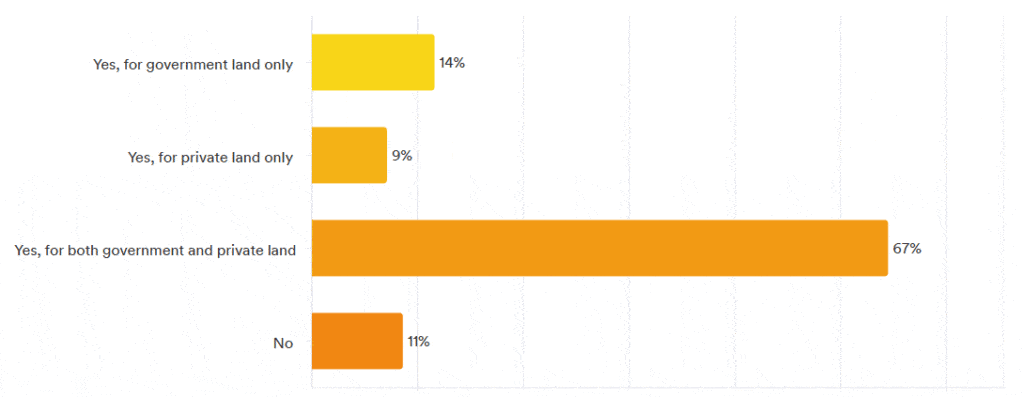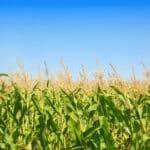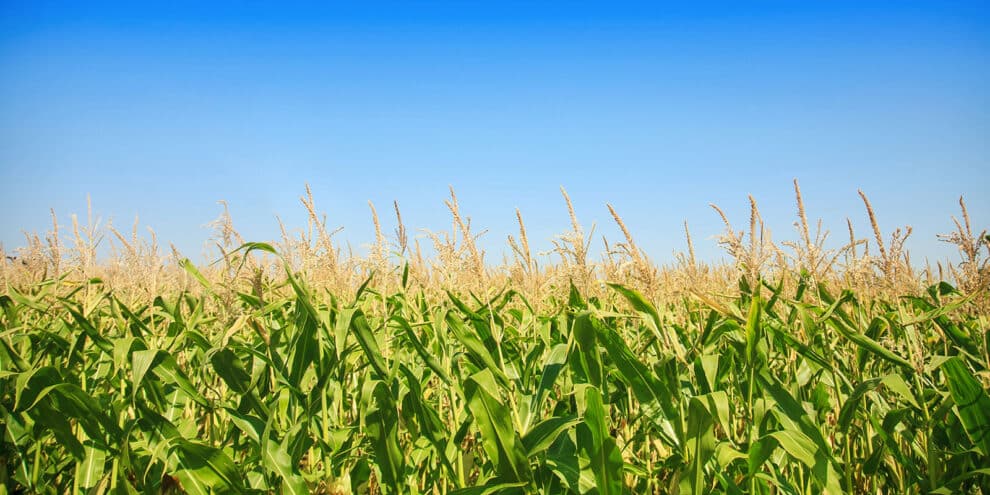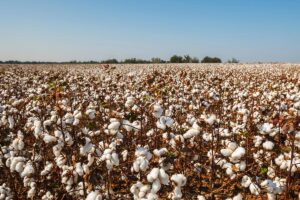Last month, the LANDTHINK Pulse posed the following question to our audience: Should there be a federal farm policy to protect and maintain our nation’s most fertile, productive land for agricultural use?
America’s farmland is irreplaceable. It is crucial not just for the sheer economic value, but also because of its critical role in ensuring the country’s food supply in tumultuous times. However, every day, the amount of fertile farmland diminishes as development spreads. According to the American Farmland Trust, the U.S. is losing forty acres of farm and ranch land every hour to new development, this means that about 3 acres of farmland is lost every minute. Since 1982, America has converted 24 million acres of agricultural land to developed uses. Our informal online survey revealed that 67% of respondents are concerned about the future of farmland and believe that federal farm policies should exist in order to safeguard our nation’s agricultural resources.

Urban sprawl has absorbed agricultural land for commercial, residential, and industrial development. While urban development converted mostly cropland, low-density residential development took an equal toll on cropland and pastures. Solar farms are also a primary culprit in unnecessary prime farmland loss. Solar farms have exploded in the past few years, due in part to the Inflation Reduction Act.
More than 10% of the earth’s agricultural land is found in the U.S. It includes crop, pasture, range and wooded lands which sustain basic human needs for food, fiber and fuel. It supports millions of jobs and the nation’s balance of trade. The escalating loss of productive agricultural land is not an isolated occurrence or happening only in selected regions. Instead, it is a widespread problem that is depleting the vital natural resource of farmland across the nation.
Prime agriculture land in the United States is facing both domestic and foreign threats. Foreign investment in U.S. agricultural land has increased significantly, and only recently has come under scrutiny, regrind the threat to national security and the potential for foreign entities to control the U.S. food supply. China, for example, owns nearly 350,000 acres of American agricultural land. At the federal level, the Committee on Foreign Investment in the United States (CFIUS) is authorized to review purchases of land around sensitive facilities such as airports, maritime ports, and military installations. Farmland, however, does not fall under that scope.
Several bills have been introduced in Congress to restrict foreign ownership of agricultural land, particularly by China. For example, the “Prohibition of Agricultural Land for the People’s Republic of China Act” (H.R. 809) would require the President to prohibit Chinese nationals and entities from purchasing agricultural land or participating in USDA programs unrelated to food safety.
Many states have passed laws or are considering legislation to restrict foreign ownership of land, including agricultural land, with some specifically targeting China or foreign entities of concern. For instance, Georgia has a bill that bans any “agent” of China from buying farmland. North Carolina’s Regulatory Reform Act of 2024, for example, regulates foreign ownership of high purity quartz mines and associated lands, while SB 548 in West Virginia restricts certain foreign nationals from participating in public land auctions.
Protecting U.S. farmland from development involves strategies like agricultural conservation easements, which limit non-farm development and ensure land remains available for farming. The federal government also plays a role through programs like the Agricultural Conservation Easement Program (ACEP) and the Farmland Protection Policy Act (FPPA).
There are many locations across America that has few to no policies related to farmland preservation. Without effective farmland preservation policy, communities continue to have little control over what land is developed. Due to relatively flat topography and deep fertile soils, land that qualifies as prime farmland is also the most readily available and least expensive for the construction of urban development. Therefore, this type of land has the greatest potential to become part of the unchecked sprawling pattern of urban development. Federal farmland preservation policies are being introduced and enacted in order to protect prime farmland and directly benefit both the rural and urban communities.
Federal policies and programs play a major role in directing development. Yet while the U.S. has strong protections in place for wetlands, endangered species, and other natural resources, protecting agricultural land has largely been left to state and local governments. Based on the results of last month’s survey question, it is time for stronger and more coordinated federal action.
With increased development threatening Georgia’s agricultural lands, the Georgia General Assembly made conservation a top priority during the 2023 legislative session. The Georgia Legislature overwhelmingly passed Senate Bill 220, the Georgia Farmland Conservation Act, which will offer farmland owners a financial incentive through the Georgia Farmland Conservation Fund Program to conserve lands when faced with pressure to develop. The measure creates a fund and a process for providing a financial incentive to farmers who volunteer to permanently place their agricultural land in a conservation easement. Doing so would restrict the landowner’s right to develop the property in the future. The Georgia Farmland Conservation Act was signed into law by Governor Brian Kemp on April 18, 2023.
In March, U.S. Senator Mitch McConnell (R-KY) introduced The Protecting American Farmlands Act, legislation that reduces the tax burden on selling farmland, encouraging farmers to keep their land in agricultural production and curbing the loss of farmland across the country. In summary, the Protecting American Farmlands Act is a legislative effort to address the decline in farmland by providing tax incentives for farmers to keep their land in agricultural production and facilitate its transfer to other farmers, thereby supporting the agricultural sector and preserving valuable farmland.
Preserving U.S. farmland on privately owned land is a multifaceted issue involving government programs, conservation easements, and land-use planning. These efforts aim to prevent the conversion of agricultural land to non-farm uses and to ensure the long-term viability of farming and ranching.
The future of farming and food security depends on keeping farmers on the land and preventing reckless development that prioritizes profit over community and food sustainability. Farmland is not just about producing food; it’s about keeping the ecosystem balanced, preserving local economies, and ensuring a secure food supply for future generations. When land is lost to development, it’s lost forever.
Do you have a suggestion for next month’s Pulse question? Submit your question and we might choose yours!
This content may not be used or reproduced in any manner whatsoever, in part or in whole, without written permission of LANDTHINK. Use of this content without permission is a violation of federal copyright law. The articles, posts, comments, opinions and information provided by LANDTHINK are for informational and research purposes only and DOES NOT substitute or coincide with the advice of an attorney, accountant, real estate broker or any other licensed real estate professional. LANDTHINK strongly advises visitors and readers to seek their own professional guidance and advice related to buying, investing in or selling real estate.










It doesn’t make sense for us to be importing most of our produce from other countries when we have so much land, some other countries do not sell land to non-national citizens, they may rent for 99 years and let you build on the land, etc. but you cannot own the land. We should not be selling our nation to non-national citizens. Also the gov’t used to “subsidize” farmers buy paying them to not grow certain produce. That is BS. Subsidize them to grow what is needed! we have the land and despite what certain politicians do, we do have the water if we quit dumping it into the ocean. We need to start feeding America and quit relying so much on other countries. Bring back farming and help make America self-reliable.